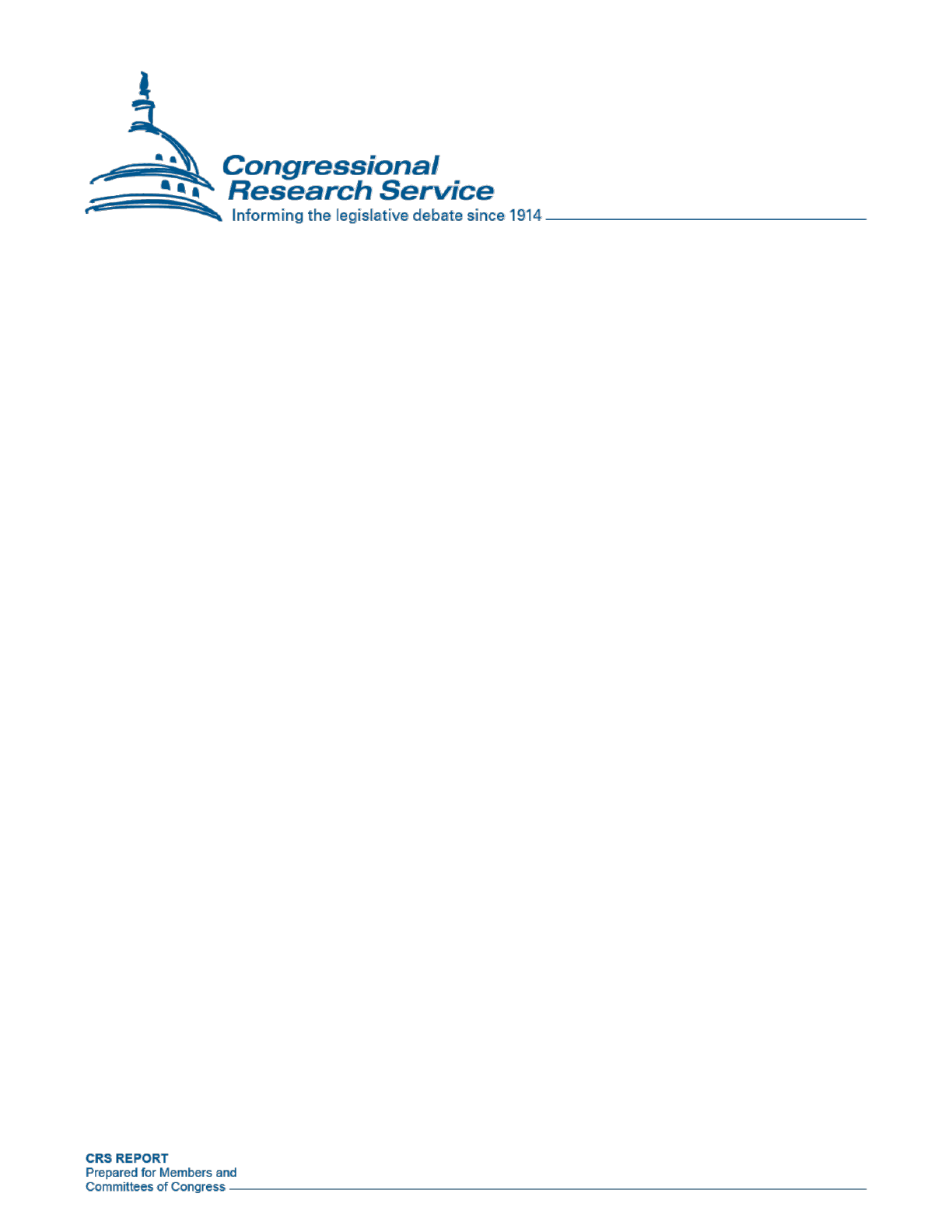
U.S. Periods of War and Dates of
Recent Conflicts
Updated February 5, 2024
Congressional Research Service
https://crsreports.congress.gov
RS21405

U.S. Periods of War and Dates of Recent Conflicts
Congressional Research Service
Summary
Many wars or conflicts in U.S. history have federally designated “periods of war,” dates marking
their beginning and ending. These dates are important for qualification for certain veterans’
pension or disability benefits. Confusion can occur because beginning and ending dates for
“periods of war” in many nonofficial sources are often different from those given in treaties and
other official sources of information, and armistice dates can be confused with termination dates.
This report lists the beginning and ending dates for “periods of war” found in Title 38 of the Code
of Federal Regulations, dealing with the Department of Veterans Affairs (VA). It also lists and
differentiates other beginning dates given in declarations of war, as well as termination of
hostilities dates and armistice and ending dates given in proclamations, laws, or treaties. The
dates for the recent conflicts in Afghanistan and Iraq are included along with the official end date
for Operation New Dawn in Iraq on December 15, 2011, Operation Enduring Freedom in
Afghanistan on December 28, 2014, and Operation Freedom’s Sentinel on September 30, 2021.
Operation Inherent Resolve continues along the Syrian-Iraqi border effective October 15, 2014.
Operation Enduring Sentinel, initiated on October 1, 2021 to counter terrorist threats from
Afghanistan, remains ongoing.
For additional information, see the following CRS Products: CRS In Focus IF10539, Defense
Primer: Legal Authorities for the Use of Military Forces, by Jennifer K. Elsea; CRS Report
R42699, The War Powers Resolution: Concepts and Practice, by Matthew C. Weed; CRS Report
RL31133, Declarations of War and Authorizations for the Use of Military Force: Historical
Background and Legal Implications, by Jennifer K. Elsea and Matthew C. Weed.

U.S. Periods of War and Dates of Recent Conflicts
Congressional Research Service
Contents
War Dates ........................................................................................................................................ 1
Indian Wars ...................................................................................................................................... 1
Spanish-American War .................................................................................................................... 1
Mexican Border Period.................................................................................................................... 2
World War I ..................................................................................................................................... 2
World War I against Germany ................................................................................................... 2
World War I against Austria-Hungary ....................................................................................... 2
World War II .................................................................................................................................... 2
World War II with Germany ...................................................................................................... 3
World War II with Japan............................................................................................................ 3
World War II with Italy ............................................................................................................. 3
World War II with Bulgaria ....................................................................................................... 3
World War II with Hungary ....................................................................................................... 4
World War II with Romania ...................................................................................................... 4
Korean Conflict ............................................................................................................................... 4
Vietnam Era ..................................................................................................................................... 4
Tonkin Gulf Resolution ............................................................................................................. 4
Selected Military Operations (1980-1996) in Lebanon 1982-1983, Grenada 1983, and
Panama 1989-1990 ....................................................................................................................... 5
Persian Gulf War ............................................................................................................................. 5
Recent Conflicts: Afghanistan and Iraq ........................................................................................... 6
Afghanistan—Operation Enduring Freedom (OEF) ................................................................. 6
Afghanistan—Operation Freedom’s Sentinel (OFS) ................................................................ 7
Afghanistan—Operation Enduring Sentinel (OES) .................................................................. 9
Iraq—Operation Iraqi Freedom (OIF)..................................................................................... 10
Iraq—Operation New Dawn (OND) ........................................................................................ 11
Islamic State-Operation Inherent Resolve (OIR) .................................................................... 12
Contacts
Author Information ........................................................................................................................ 13

U.S. Periods of War and Dates of Recent Conflicts
Congressional Research Service 1
War Dates
Congress, usually through a declaration of war, has often been the first governmental authority to
designate the beginning date of a war or armed conflict. The President, or executive branch
officials responsible to him, through proclamation, or Congress, through legislation, has been
responsible for designating the war’s termination date.
1
In some cases, later legislation is enacted
to extend these beginning and ending dates for the purpose of broadening eligibility for veterans’
benefits.
2
This report notes the variations in the dates cited in the Code of Federal Regulations
(C.F.R.) “periods of war” and those dates given in the declarations of war beginning and the
proclamations, laws, or treaties terminating such conflicts.
3
Adding to the confusion, during
World War II, wars were declared and terminated with six individual combatant countries.
Moreover, armistice dates are also often confused with termination dates.
4
Title 38, Part 3, Section 3.2 of the Code of Federal Regulations, dealing with the Department of
Veterans Affairs (VA), lists official beginning and termination dates for most war periods from the
Indian Wars to the present to be used in determining the availability of veterans’ benefits.
5
The
material below summarizes these dates. Where applicable, a summary of the Department of
Veterans Affairs official beginning and termination dates is provided followed by a citation to the
lettered C.F.R. section. For some entries, this initial summary is followed by an explanatory note
or declaration, armistice, cease-fire, or termination dates cited by other official sources. Also
included are dates for the recent conflicts in Iraq and Afghanistan.
Indian Wars
January 1, 1817, through December 31, 1898, inclusive. Service must have been rendered with
U.S. military forces against Indian tribes or nations. Code of Federal Regulations, 3.2 (a).
Spanish-American War
April 21, 1898, through July 4, 1902, inclusive. If the veteran served with the U.S. military forces
engaged in hostilities in the Moro Province, the ending date is July 15, 1903. The Philippine
1
For background on the War Powers Act and use of military force abroad, see the following: CRS Report RL31133,
Declarations of War and Authorizations for the Use of Military Force: Historical Background and Legal Implications,
by Jennifer K. Elsea and Matthew C. Weed; CRS In Focus IF10539, Defense Primer: Legal Authorities for the Use of
Military Forces, by Jennifer K. Elsea; and CRS Report R42699, The War Powers Resolution: Concepts and Practice,
by Matthew C. Weed.
2
The American Legion also follows these dates closely in determining who is eligible for membership; the Veterans of
Foreign Wars has its own much more elaborate list of dates.
3
Code of Federal Regulations (C.F.R.) Title 38, Part 3, §3.2 Periods of war, at https://www.ecfr.gov/current/title-
38/chapter-I/part-3/subpart-A/subject-group-ECFRf5fe31f49d4f511/section-3.2.
4
Armistice—“In International law, a suspension or temporary cessation of hostilities by agreement between belligerent
powers.” Department of Defense Dictionary of Military and Associated Terms, Joint Publication 1-02, Department of
Defense, 12 April 2010, on p. 36 at https://fas.org/irp/doddir/dod/jp1_02-april2010.pdf.
5
Title 38 of the C.F.R., titled “Pensions, Bonuses and Veterans’ Relief,” is not to be confused with Title 38 of the
United States Code, titled “Veterans Benefits.” Laws enacted in each Congress are first collected as session laws,
published in the Statutes at Large for each session. These laws are then codified by subject and published in the United
States Code. The general guidance given by these laws results in the issuance of more detailed regulations to
implement these laws. Such regulations are first published in the Federal Register and are then codified by subject in
the C.F.R.

U.S. Periods of War and Dates of Recent Conflicts
Congressional Research Service 2
Insurrection and the Boxer Rebellion are included for the purposes of benefit determination under
this C.F.R. section. Code of Federal Regulations, 3.2 (b).
Declared by an act of Congress April 25, 1898 (30 Stat. 364, Ch. 189). An armistice signed
August 12, 1898. Terminated by Treaty signed at Paris, December 10, 1898 (30 Stat. 1754),
ratified and proclaimed April 11, 1899.
Mexican Border Period
May 9, 1916, through April 5, 1917. In the case of a veteran who during such period served in
Mexico, on the borders thereof, or in the adjacent waters thereto. Code of Federal Regulations,
3.2 (h).
World War I
April 6, 1917, through November 11, 1918, inclusive. If the veteran served with the U.S. military
forces in Russia, the ending date is April 1, 1920. Service after November 11, 1918, and before
July 2, 1921, is considered World War I service if the veteran served in the active military, naval,
or air service after April 5, 1917, and before November 12, 1918. Code of Federal Regulations,
3.2 (c).
World War I against Germany
Declared by Joint Resolution of Congress of April 6, 1917 (40 Stat. 429, Ch. 1). Armistice signed
near Compiègne, France, November 11, 1918. Terminated July 2, 1921, by Joint Resolution of
Congress (42 Stat. 105, Ch. 40, 1).
World War I against Austria-Hungary
Declared by Joint Resolution of Congress, December 7, 1917 (40 Stat. 429, Ch. 1). An armistice
signed near Compiègne, France, November 11, 1918. Terminated July 2, 1921, by Joint
Resolution of Congress (42 Stat. 106, Ch. 40, 3).
World War II
December 7, 1941, through December 31, 1946, inclusive. If the veteran was in service on
December 31, 1946, continuous service before July 26, 1947, is considered World War II service.
Code of Federal Regulations, 3.2 (d).
During World War II, war was officially declared against six separate countries. The war with
each was not over until the effective date of the Treaty of Peace. Note also the confusion cited
below over which day is the official Victory in Europe Day (V-E Day)
6
and Victory over Japan
6
May 7, 1945, is listed as V-E Day in commentary about signing the first German surrender document in Historic
Documents of World War II by Walter Consuelo Langsam (Westport, CT: Greenwood Press, 1958), p. 144. However,
May 8, 1945, is cited as V-E day in The Encyclopedia of American Facts and Dates, p. 528; as the “Official V-E Day”
in Louis L. Snyder, Louis L. Snyder’s Historical Guide to World War Two (Westport, CT: Greenwood, 1982), p. 736;
and the World Almanac of World War II, ed. Brigadier Peter Young (New York: Pharos Books, 1981), p. 347, states in
its chronology for May 8, “The British and Americans celebrate VE Day (Victory in Europe Day). Truman, Churchill
and King George VI all make special broadcasts.” Although President Truman did not officially proclaim May 7 as V-
(continued...)

U.S. Periods of War and Dates of Recent Conflicts
Congressional Research Service 3
Day (V-J Day).
7
World War II with Germany
Declared by Joint Resolution of Congress, December 11, 1941 (55 Stat. 796, Ch. 564). German
representative Colonel General Alfred Jodl signed the unconditional act of surrender to Allied
representatives in a schoolhouse in Reims, France, on May 7, 1945. A second German surrender
ceremony was held on May 8 in Berlin at the insistence of the U.S.S.R. Cessation of hostilities
declared as of noon, December 31, 1946, by presidential proclamation of December 31, 1946
(Proc. no. 2714, 61 Stat. 1048). State of war with the “government of Germany” terminated
October 19, 1951, by Joint Resolution of Congress of that date (65 Stat. 451, Ch. 519), by
Presidential Proclamation 2950, October 24, 1951. No peace treaty with Germany was signed.
World War II with Japan
Declared by Joint Resolution of Congress, December 8, 1941 (55 Stat. 795, Ch. 561). Japanese
representatives publicly signed unconditional surrender document on the deck of the USS
Missouri anchored in Tokyo Bay on September 2, 1945. President Truman proclaimed this date
Victory over Japan Day or V-J Day. Cessation of hostilities declared as of 12 noon, December 31,
1946, by presidential proclamation of December 31, 1946 (Proc. no. 2714, 61 Stat. 1048).
Terminated by Multilateral Treaty of Peace with Japan, signed at San Francisco, September 8,
1951 (3 UST 3329), and ratified March 20, 1952, effective April 28, 1952.
World War II with Italy
Declared by Joint Resolution of Congress, December 11, 1941 (55 Stat. 797, Ch. 565). Cessation
of hostilities declared as of noon December 31, 1946, by presidential proclamation of December
31, 1946 (Proc. no. 2714, 61 Stat. 1048). Terminated by Treaty of Peace dated at Paris, February
10, 1947 (61 Stat. 1247), effective September 15, 1947.
World War II with Bulgaria
Declared by Joint Resolution of Congress, June 5, 1942 (56 Stat. 307, Ch. 323). Cessation of
hostilities declared as of noon December 31, 1946, by presidential proclamation of December 31,
E (Victory in Europe) Day, he did proclaim Sunday, May 13, 1945, a day of prayer. To make for more confusion, his
May 8, 1945, Proclamation 2651, proclaiming May 13 as a day of prayer, is titled, “Victory in Europe; Day of Prayer”
(3 C.F.R., 1943-1948 Comp.), p. 55. In addition, his May 8 news conference in which he proclaims May 13 a day of
prayer is titled, “The President’s News Conference on V-E Day”—Public Papers of the Presidents of the United States.
Harry S. Truman, 1945 (Washington: GPO, 1961), p. 43.
7
In his news conference of August 14, 1945, announcing news of the Japanese government’s complete acceptance of
terms of surrender, President Truman states, “Proclamation of V-J Day must wait upon the formal signing of the
surrender terms by Japan.”—Public Papers, p. 216. The proclamation of September 2 as V-J Day was given in his
September 1, 1945, “Speech to the American People after the Signing of the Terms of Unconditional Surrender by
Japan.”—Public Papers, p. 254. However, no formal, numbered proclamation was apparently issued. Both August 14,
the day of President Truman’s announcement of the Japanese surrender, and September 2, the official day proclaimed
by President Truman in his speech, are cited as V-J Day in Chase’s Calendar of Events 2002 (New York: McGraw-
Hill, 2002), pp. 421 and 555. August 15 is cited as V-J Day by The Encyclopedia of American Facts and Dates, 9
th
ed.,
by Gordon Carruth (New York: Harper Collins, 1993), p. 530. August 15, on which the Japanese Emperor made his
historic broadcast to the Japanese people telling of Japan’s surrender, is cited as V-J Day in The World Almanac of
World War II, p. 353.

U.S. Periods of War and Dates of Recent Conflicts
Congressional Research Service 4
1946 (Proc. no. 2714, 61 Stat. 1048). Terminated by Treaty of Peace dated at Paris, February 10,
1947 (61 Stat. 1915), effective September 15, 1947.
World War II with Hungary
Declared by Joint Resolution of Congress, June 5, 1942 (56 Stat. 307, Ch. 324). Cessation of
hostilities declared as of noon December 31, 1946, by presidential proclamation (Proc. no. 2714,
61 Stat. 1048). Terminated by Treaty of Peace dated at Paris, February 10, 1947 (61 Stat. 1757),
effective September 15, 1947.
World War II with Romania
Declared by Joint Resolution of Congress, June 5, 1942 (56 Stat. 307, Ch. 325). Cessation of
hostilities declared as of noon December 31, 1946, by presidential proclamation of December 31,
1946 (Proc. no. 2714, 61 Stat. 1048). Terminated by Treaty of Peace dated at Paris, February 10,
1947 (61 Stat. 1757), effective September 15, 1947.
Korean Conflict
June 27, 1950, through January 31, 1955, inclusive. Code of Federal Regulations, 3.2 (e).
On June 25, 1950, North Korean Communist forces attacked South Korean positions south of the
38
th
parallel, leading to an immediate United Nations (U.N.) Security Council resolution calling
for a cease-fire and withdrawal of the North Korean forces. On June 26, President Truman
ordered U.S. air and sea forces in the Far East to aid South Korea. On June 27, the U.N. Security
Council adopted a resolution asking U.N. members for assistance in repelling the North Korean
armed attack and in restoring peace and security in the area. On June 30, the President stated that
he had authorized the use of certain U.S. air and ground units wherever necessary. No declaration
of war was requested of Congress and no authorization for use of force, by statute, was requested
or enacted. An armistice signed at Panmunjom, Korea, on July 27, 1953, between U.N. and
Communist representatives (4 UST 234; TIAS 2782). No peace treaty was ever signed.
Vietnam Era
The period beginning on November 1, 1955, and ending on May 7, 1975, inclusive, in the case of
a veteran who served in the Republic of Vietnam during that period. The period beginning on
August 5, 1964, and ending on May 7, 1975, inclusive, in all other cases. Code of Federal
Regulations, 3.2 (f).
Tonkin Gulf Resolution
No declaration of war was requested of Congress. Instead, there was a Joint Resolution of
Congress to promote the maintenance of international peace and security in Southeast Asia, which
stated in part that Congress “approves and supports the determination of the President, as
Commander in Chief, to take all necessary measures to repel any armed attack against the forces
of the United States and to prevent any further aggression.” H.J. Res. 1145, P.L. 88-408, August
10, 1964 (78 Stat. 384). The Tonkin Gulf Resolution was formally repealed on January 12, 1971,
by P.L. 91-672, (84 Stat. 2055). The Agreement Ending the War and Restoring Peace in Vietnam
signed in Paris, January 27, 1973 (TIAS 7674). Joint communiqué implementing the agreement
and protocols of January 27, 1973, signed at Paris and entered into force, June 13, 1973.

U.S. Periods of War and Dates of Recent Conflicts
Congressional Research Service 5
Selected Military Operations (1980-1996) in Lebanon
1982-1983, Grenada 1983, and Panama 1989-1990
Lebanon. U.S. Marines deployed on August 21, 1982 and September 29, 1982, were part of a
temporary multinational force in Lebanon. See S. 639, P.L. 98-43 (Lebanon Emergency
Assistance Act of 1983).
8
Grenada. On October 25, 1983, U.S. troops were deployed to Grenada “to restore law and order”
and to protect American lives at the request of the members of the Organization of Eastern
Caribbean States. Known as Operation Urgent Fury,
9
by December 15, 1983, all forces were
withdrawn.
Panama. On December 21, 1989, President George H.W. Bush reported that he had ordered U.S.
military forces to Panama to protect the lives of American citizens and bring General Noriega to
justice. Known as Operation Just Cause,
10
by February 13, 1990, all U.S. forces were withdrawn.
Participation in these conflicts alone does not confer automatic veterans’ status for
servicemembers. For more information, see CRS Report R47299, U.S. Department of Veterans
Affairs: Who Is a Veteran?, by Scott D. Szymendera, and CRS Report RL31133, Declarations of
War and Authorizations for the Use of Military Force: Historical Background and Legal
Implications, by Jennifer K. Elsea and Matthew C. Weed.
Persian Gulf War
August 2, 1990, through April 6, 1991, when Iraq officially accepted cease-fire terms. Congress
passed H.J.Res. 77, Authorizing the Use of Military Force against Iraq, the same day it was
introduced (January 12, 1991), and it was signed by President George H.W. Bush on January 14,
1991 (P.L. 102-1). Operation Desert Storm
11
and the air war phase began at 3 a.m. January 17,
1991 (January 16, 7 p.m. Eastern Standard Time). Allied ground assault began at 4 a.m. February
24 (February 23, 8 p.m. EST). Cease-fire declared at 8:01 a.m. February 28, 1991 (12:01 a.m.
EST).
12
Cease-fire terms negotiated at Safwan, Iraq, March 1, 1991.
13
Iraq officially accepted
8
See also S.J.Res. 159 (P.L. 98-119) authorizing the President to keep U.S. forces in Lebanon for as long as 18 months,
or until April 1985; and “A Reluctant Congress Adopts Lebanon Policy,” CQ Almanac 1983 at
https://library.cqpress.com/cqalmanac/document.php?id=cqal83-1198422.
9
Ronald H. Cole, Operation Urgent Fury The Planning and Execution of Joint Operations in Grenada 12 October - 2
November 1983, Joint History Office, Office of the Chairman of the Joint Chiefs of Staff, Washington, DC 1997, at
https://www.jcs.mil/Portals/36/Documents/History/Monographs/Urgent_Fury.pdf.
10
Cole, Operation Just Cause The Planning and Execution of Joint Operations in Panama February 1988 – January
1990, Joint History Office, Office of the Chairman of the Joint Chiefs of Staff, Washington, DC 1995, at
https://www.jcs.mil/Portals/36/Documents/History/Monographs/Just_Cause.pdf.
11
Shannon Collins, “Desert Storm: A Look Back,” DOD News Feature, January 11 2019, at
https://www.defense.gov/Explore/Features/story/Article/1728715/desert-storm-a-look-back/.
12
Cease fire— “A command given to any unit or individual firing any weapon to stop engaging the target.” Department
of Defense Dictionary, p. 67.
13
This agreement is actually a transcript of the discussion held at Safwan Airfield, Iraq, between Coalition participants,
U.S. Gen. M. Norman Schwarzkopf and Lt. Gen. Khalid of the Joint Arab Forces, and Iraqi participants, Lt. Gen.
Sultan Kasim Ahmad, Chief of Staff of the Ministry of Defense, and Lt. Gen. Sala Abud Mahmud, III Corps
Commander.

U.S. Periods of War and Dates of Recent Conflicts
Congressional Research Service 6
cease-fire terms, April 6, 1991.
14
Cease-fire took effect April 11, 1991. Currently, the Code of
Federal Regulations, 3.2 (i) does not list an official end date.
15
Recent Conflicts: Afghanistan and Iraq
Shortly after the terrorist attacks in the United States on September 11, 2001, President George W.
Bush called on Afghanistan’s leaders to hand over Osama bin Laden and other al Qaeda leaders
and close their terrorist training camps. He also demanded the return of all detained foreign
nationals and the opening of terrorist training sites to inspection.
16
These demands were rejected.
The Administration sought international support from the United Nations for military action
against Afghanistan. U.N. Security Council Resolution 1368 of September 12, 2001, stated that
the Council “Expresses its readiness to take all necessary steps to respond to the terrorist attacks
of September 11, 2001 ...”
17
This resolution was interpreted by many as U.N. authorization for
military action in response to the 9/11 attacks. As a result, Congress passed S.J.Res. 23,
“Authorization for Use of Military Force,” on September 14, 2001. This bill was signed by
President George W. Bush on September 18, 2001, as P.L. 107-40, and it authorized the President
to use “all necessary and appropriate force against those nations, organizations, or persons he
determines planned, authorized, committed, or aided the terrorist attacks that occurred on
September 11, 2001, or harbored such organizations or persons.... ”
18
Operations in the region
began with U.S. military forces deployed to the region on October 7, 2001.
See CRS Report R41989, Congressional Authority to Limit Military Operations, by Jennifer K.
Elsea, Michael John Garcia, and Thomas J. Nicola.
Afghanistan—Operation Enduring Freedom (OEF)
Operations began with U.S. military forces deployed to Afghanistan to combat terrorism on
October 7, 2001, and designated Operation Enduring Freedom.
On March 27, 2009, President Barack Obama announced a new strategy in Afghanistan and
Pakistan and ordered the deployment of 17,000 troops that had been previously requested by
General David McKiernan.
19
In President Obama’s “Address to the Nation on the Way Forward
in Afghanistan and Pakistan” at West Point on December 1, 2009, he stated that “it is in our vital
national interest to send an additional 30,000 U.S. troops to Afghanistan. After 18 months, our
troops will begin to come home. These are the resources that we need to seize the initiative, while
14
Acceptance is in the form of a letter to the U.N. Security Council accepting the terms of U.N. Resolution 687 (U.N.
document S22485, April 11, 1991).
15
38 C.F.R. Part 3, §3.2 Periods of war, at https://www.ecfr.gov/current/title-38/chapter-I/part-3/subpart-A/subject-
group-ECFRf5fe31f49d4f511/section-3.2. Note: Section (i) for the Persian Gulf War lists “August 2, 1990, through
date to be prescribed by Presidential proclamation or law.” No specific end date is listed as of the date of this report.
16
President George W. Bush, “Address Before A Joint Session of Congress on the United States Response to the
Terrorist Attacks of September 11,” September 20, 2001, p. 57/PDF p. 65, at https://georgewbush-
whitehouse.archives.gov/infocus/bushrecord/documents/Selected_Speeches_George_W_Bush.pdf.
17
United Nations, Security Council Resolution 1368 (2001), adopted by the Security Council at its 4370
th
meeting, on
September 12, 2001, at https://digitallibrary.un.org/record/448051.
18
P.L. 107-40, “To authorize the use of United States Armed Forces against those responsible for the recent attacks
launched against the United States,” at https://www.govinfo.gov/content/pkg/PLAW-107publ40/pdf/PLAW-
107publ40.pdf.
19
The White House, Office of the Press Secretary, “Remarks by the President on a New Strategy for Afghanistan and
Pakistan,” press release, March 27, 2009, at https://obamawhitehouse.archives.gov/the-press-office/remarks-president-
a-new-strategy-afghanistan-and-pakistan.

U.S. Periods of War and Dates of Recent Conflicts
Congressional Research Service 7
building the Afghan capacity that can allow for a responsible transition of our forces out of
Afghanistan.”
20
On June 22, 2011, President Obama again addressed the American people about the way forward
in Afghanistan: “We will begin the drawdown of U.S. troops from a position of strength. We have
exceeded our expectations on our core goal of defeating al-Qaeda killing 20 of its top 30 leaders,
including Osama bin Laden. We have broken the Taliban’s momentum, and trained over 100,000
Afghan National Security Forces.”
21
As a result, U.S. forces began the withdrawal of 10,000
troops from Afghanistan.
On December 28, 2014, after 13 years of combat operations, President Obama and Secretary of
Defense Hagel announced the end of OEF and the beginning of a follow-on mission on January 1,
2015.
22
A transition ceremony was held at the International Security and Assistance Force
headquarters in Kabul, Afghanistan, attended by U.S. commanders and allied troops from the
North Atlantic Treaty Organization (NATO).
Afghanistan—Operation Freedom’s Sentinel (OFS)
Effective January 1, 2015, Secretary of Defense Hagel announced that the U.S. mission in
Afghanistan would focus on training, advising, and assisting Afghan security forces and
designated it as Operation Freedom’s Sentinel.
23
During 2015, approximately 13,000 troops, with
nearly 10,000 from the United States, were deployed from 41 nations to begin NATO’s Resolute
Support Mission (RSM).
24
RSM focused on training, advising, and assisting (TAA) the Afghan
Security Institutions (ASI) and the Afghan National Defense & Security Forces (ANDSF) in
order to build their capabilities and long-term sustainability.
25
On October 1, 2015, General John
F. Campbell, commander, RSM, U.S. Forces-Afghanistan/ISAF, defined the U.S. military’s
objectives: “U.S. forces are now carrying out two well-defined missions: a Counter-Terrorism
20
The White House, Office of the Press Secretary, “Remarks by the President in Address to the Nation on the Way
Forward in Afghanistan and Pakistan,” press release, December 1, 2009, at https://obamawhitehouse.archives.gov/the-
press-office/remarks-president-address-nation-way-forward-afghanistan-and-pakistan.
21
The White House, Office of the Press Secretary, “Remarks by the President on the Way Forward in Afghanistan,”
press release, June 22, 2011, at https://obamawhitehouse.archives.gov/the-press-office/2011/06/22/remarks-president-
way-forward-afghanistan.
22
U.S. Department of Defense (DOD), “Obama, Hagel Mark End of Operation Enduring Freedom,” news release,
December 28, 2014, at https://dod.defense.gov/News/Article/Article/603860/obama-hagel-mark-end-of-operation-
enduring-freedom/.
23
DOD, “Statement by Secretary of Defense Chuck Hagel on Operation Enduring Freedom and Operation Freedom’s
Sentinel,” news release, NR-631-14, December 28, 2014, at https://dod.defense.gov/News/News-Releases/News-
Release-View/Article/605332/statement-by-secretary-of-defense-chuck-hagel-on-operation-enduring-freedom-and/.
24
Gen. John F. Campbell, Commander, Resolute Support Mission, U.S. Forces-Afghanistan/ISAF, “Operation
Freedom's Sentinel and Our Continued Security Investment in Afghanistan,” Army.mil, October 5, 2015, at
https://www.army.mil/article/156517/operation_freedoms_sentinel_and_our_continued_security_investment_in_afgha
nistan. For numbers of contributing nations and troop levels for the duration of the mission (2015-2021), see NATO
and Afghanistan: RSM Placemats Archive at https://www.nato.int/cps/en/natolive/107995.htm.
25
NATO, Resolute Support Mission in Afghanistan, May 30, 2022, at
https://www.nato.int/cps/en/natohq/topics_113694.htm. At the 2016 NATO Summit in Warsaw, Allied leaders decided
to extend the presence of RSM beyond 2016. Two years later, at the Brussels Summit in July 2018, they committed to
sustaining the mission until conditions indicate a change is appropriate. In February 2020, the U.S. and the Taliban
agreed to the withdrawal of international forces by May 2021. In April 2021, the NATO Allies decided to begin the
withdrawal of RSM forces by May 1, 2021. The RSM was terminated in September 2021. For information on the U.S.-
Taliban agreement, see CRS Report R46879, U.S. Military Withdrawal and Taliban Takeover in Afghanistan:
Frequently Asked Questions, coordinated by Clayton Thomas; and CRS Report R45122, Afghanistan: Background and
U.S. Policy, by Clayton Thomas.

U.S. Periods of War and Dates of Recent Conflicts
Congressional Research Service 8
(CT) mission against the remnants of Al-Qaeda and the Resolute Support TAA mission in support
of Afghan security forces. Our CT and TAA efforts are concurrent and complementary. While we
continue to attack the remnants of Al-Qaeda, we are also building the ANDSF so that they can
secure the Afghan people, win the peace, and contribute to stability throughout the region.”
26
On
October 15, 2015, President Obama announced that the posture of 9,800 U.S. troops in
Afghanistan would remain through 2016. By the end of 2016, 5,500 troops were expected to
remain in Afghanistan to support the U.S. embassy in Kabul and at bases in Bagram, Jalalabad,
and Kandahar to train Afghans and focus on counterterrorism operations in the region.
27
On August 21, 2017, President Donald Trump announced his strategy in Afghanistan and South
Asia in a speech at Fort Myer, VA. He stated, “In Afghanistan and Pakistan, America’s interests
are clear: We must stop the resurgence of safe havens that enable terrorists to threaten America,
and we must prevent nuclear weapons and materials from coming into the hands of terrorists and
being used against us, or anywhere in the world for that matter.”
28
On September 2, 2018, Army General John M. Nicholson passed command of NATO’s Resolute
Support Mission and U.S. Forces Afghanistan to Army General Austin S. Miller during a
ceremony in Kabul, Afghanistan.
29
General Miller emphasized to coalition troops that what they
are doing in Afghanistan makes their own countries and citizens safer. The “train, advise, assist”
mission allows Afghan security forces to take the fight to the enemy, and to give the Afghan
government the security needed to provide stability and no longer a safe haven for terrorists.
30
In
February 2020, the Trump Administration announced that the United States had entered into an
agreement with the Taliban “that secures important commitments that are necessary to finally end
the conflict in Afghanistan.”
31
Per the agreement, which was signed on February 29, 2020, the
United States committed to the withdrawal of “all military forces of the United States, its allies,
and Coalition partners, including all non-diplomatic civilian personnel, private security
contractors, trainers, advisors, and supporting services personnel” from Afghanistan by the end of
April 2021.
32
26
Gen. John F. Campbell, commander, Resolute Support Mission, U.S. Forces-Afghanistan/ISAF, “Operation
Freedom’s Sentinel and our continued security investment in Afghanistan,” Army.mil, October 5, 2015, at
https://www.army.mil/article/156517/operation_freedoms_sentinel_and_our_continued_security_investment_in_afgha
nistan.
27
The White House, Office of the Press Secretary, “Statement by the President on Afghanistan,” October 15, 2015, at
https://obamawhitehouse.archives.gov/the-press-office/2015/10/15/statement-president-afghanistan.
28
The White House, Briefings and Statements, “Remarks by President Trump on the Strategy in Afghanistan and South
Asia,” August 21, 2017, at https://trumpwhitehouse.archives.gov/briefings-statements/remarks-president-trump-
strategy-afghanistan-south-asia/.
29
Jim Garamone, “Miller Takes over NATO, U.S. Commands in Afghanistan,” DOD News, September 2, 2018, at
https://dod.defense.gov/News/Article/Article/1618550/miller-takes-over-nato-us-commands-in-afghanistan/.
30
Jim Garamone, “Commander Wants Coalition Forces in Afghanistan to Know Why They Fight,” DOD News,
September 29, 2018, at https://dod.defense.gov/News/Article/Article/1649125/commander-wants-coalition-forces-in-
afghanistan-to-know-why-they-fight/.
31
The White House, Briefings and Statements, “President Donald J. Trump is Taking a Historic Step to Achieve Peace
in Afghanistan and Bring Our Troops Home,” February 29, 2020, at https://trumpwhitehouse.archives.gov/briefings-
statements/president-donald-j-trump-taking-historic-step-achieve-peace-afghanistan-bring-troops-home/.
32
State Department, Agreement for Bringing Peace to Afghanistan between the Islamic Emirate of Afghanistan which
is not recognized by the United States as a state and is known as the Taliban and the United States of America,
February 29, 2020, p. 1, at https://2017-2021.state.gov/wp-content/uploads/2020/02/Signed-Agreement-02292020.pdf.

U.S. Periods of War and Dates of Recent Conflicts
Congressional Research Service 9
On April 14, 2021, President Biden announced his intent to uphold the agreement signed under
the Trump Administration. He stated that the final withdrawal of U.S. troops from Afghanistan
would begin on May 1, 2021 and end by September 11, 2021.
33
On August 30, 2021, Secretary of Defense Lloyd Austin announced that the evacuation of
civilians and the removal of all U.S. forces from Afghanistan was complete, marking the end of
OFS and the war in Afghanistan.
34
Marine Corps General Frank McKenzie, the head of U.S.
Central Command (USCENTCOM), confirmed the end of the evacuation and the war with the
departure of the last military planes. The final C-17 left Kabul on August 30, 2021, at 3:29 p.m.
Eastern Daylight Time.
35
OFS was terminated on September 30, 2021.
36
The war in Afghanistan spanned nearly two decades and DOD reports that it claimed the lives of
2,463 U.S. servicemembers and civilians.
37
Afghanistan—Operation Enduring Sentinel (OES)
After the conclusion of OFS in September 2021, Operation Enduring Sentinel began on October
1, 2021, “as the new U.S. mission to counter terrorist threats emanating from Afghanistan.”
38
OES also aims to promote regional stability through increased counterterrorism and security
assistance engagement with regional partners in Central and South Asia.
39
Following the
withdrawal of U.S. troops from Afghanistan in 2021, terrorist organizations including ISIS-
33
The White House, Speeches and Remarks, “Remarks by President Biden on the Way Forward in Afghanistan,” April
14, 2021, at https://www.whitehouse.gov/briefing-room/speeches-remarks/2021/04/14/remarks-by-president-biden-on-
the-way-forward-in-afghanistan/.
34
DOD, “Statement by Secretary of Defense Lloyd Austin III on the End of the American War in Afghanistan,” news
release, August 30, 2021 at https://www.defense.gov/Newsroom/Releases/Release/Article/2759181/statement-by-
secretary-of-defense-lloyd-austin-iii-on-the-end-of-the-american-w/.
35
DOD, “Military Phase of Evacuation Ends, as Does America’s Longest War,” news article, August 30, 2021, at
https://www.defense.gov/Explore/News/Article/Article/2759031/military-phase-of-evacuation-ends-as-does-americas-
longest-war/.
36
DOD Office of Inspector General (OIG), Operation Enduring Sentinel, Operation Freedom’s Sentinel: Lead
Inspector General Report to the United States Congress, July 1, 2022-September 30, 2022, November 16, 2022, PDF p.
5, at https://media.defense.gov/2022/Nov/21/2003119337/-1/-
1/1/LEAD%20INSPECTOR%20GENERAL%20FOR%20OES_OFS.PDF.
37
DOD, “Casualty Status,” as of January 3, 2024, at https://www.defense.gov/casualty.pdf. Note: The total number of
deaths was obtained by combining the total deaths listed worldwide for Operation Enduring Freedom and Operation
Freedom’s Sentinel. This number includes both U.S. military casualties and DOD civilian casualties. This report is
updated periodically by DOD.
38
DOD OIG, Operation Freedom’s Sentinel, Operation Enduring Sentinel: Lead Inspector General Report to the
United States Congress, October 1, 2021-December 31, 2021, February 11, 2022, p. 2, at
https://media.defense.gov/2022/Feb/15/2002939389/-1/-
1/1/LEAD%20INSPECTOR%20GENERAL%20FOR%20OPERATION%20FREEDOM%E2%80%99S%20SENTIN
EL%20AND%20OPERATION%20ENDURING%20SENTINEL%20OCTOBER%201,%202021%20%E2%80%93%
20DECEMBER%2031,%202021.PDF; and DOD OIG, Operation Enduring Sentinel, Operation Freedom’s Sentinel:
Lead Inspector General Report to the United States Congress, July 1, 2022-September 30, 2022, November 16, 2022,
p. 5, at https://media.defense.gov/2022/Nov/21/2003119337/-1/-
1/1/LEAD%20INSPECTOR%20GENERAL%20FOR%20OES_OFS.PDF.
39
DOD OIG, Operation Freedom’s Sentinel, Operation Enduring Sentinel: Lead Inspector General Report to the
United States Congress, October 1, 2021-December 31, 2021, February 11, 2022, p. 2, at
https://media.defense.gov/2022/Feb/15/2002939389/-1/-
1/1/LEAD%20INSPECTOR%20GENERAL%20FOR%20OPERATION%20FREEDOM%E2%80%99S%20SENTIN
EL%20AND%20OPERATION%20ENDURING%20SENTINEL%20OCTOBER%201,%202021%20%E2%80%93%
20DECEMBER%2031,%202021.PDF.

U.S. Periods of War and Dates of Recent Conflicts
Congressional Research Service 10
Khorasan (ISIS-K)
40
and Al-Qaeda “have sought to exploit the reduction of U.S. counterterrorism
efforts to increase their ability to plot and direct external attacks.”
41
The OES mission is under the jurisdiction of USCENTOM and is also supported by the U.S.
Special Operations Command (USSOCOM).
42
In contrast to OFS, OES is conducted from
locations outside of Afghanistan, referred to as “over the horizon” locations.
43
Operations are
conducted by the joint headquarters in Qatar.
44
According to USCENTCOM, as of 2022, the
headquarters was staffed by about 100 personnel.
45
The DOD Office of the Inspector General (OIG) submits quarterly reports to Congress detailing
events involving OES. The latest DOD OIG report available at the time of this report’s
publication date covers the period between July 1, 2023-September 30, 2023. The report did not
include any publicly available information from DOD about U.S. military activity for OES for
this quarter.
46
Regarding terrorist activity in the region, the report noted that violent extremism
continued to pose a security threat in Afghanistan. Estimates from the Defense Intelligence
Agency include the following numbers of fighters from violent extremist organizations in
Afghanistan: 4,000 to 6,000 for Tehreek-e Taliban Pakistan, 2,000 for ISIS-K, 200 for Al-Qaeda
in the Indian Subcontinent, and “fewer than a dozen core members” for Al-Qaeda.
47
As of
September 2023, Al-Qaeda was reported to be “at an historical low point” in Afghanistan and
Pakistan.
48
Iraq—Operation Iraqi Freedom (OIF)
In mid-2002, the George W. Bush Administration began deploying U.S. troops to Kuwait. During
the 107
th
Congress (2001-2002), Congress debated whether to send U.S. troops to Iraq, and on
October 16, 2002, H.J.Res. 114 was signed into law as P.L. 107-243, Authorization for the Use of
Military Force Against Iraq Resolution of 2002. This law authorized the President to use military
force to “defend the national security of the United States against the continuing threat posed by
Iraq” and “to enforce all relevant U.N. Security Council resolutions against Iraq.”
49
40
ISIS-K is the Afghan branch of the Islamic State (IS, also known as ISIL, ISIS, or the Arabic acronym Da’esh). For
background information on ISIS, see CRS In Focus IF10328, The Islamic State, by Clayton Thomas.
41
DOID OIG, COP-OCO: FY 2023 Comprehensive Oversight Plan, Overseas Contingency Operations, October 3,
2022, p. 48, at https://media.defense.gov/2022/Oct/12/2003094906/-1/-1/1/FY2023_LEADIG_COPOCO.PDF.
42
Ibid.
43
DOD OIG, Operation Freedom’s Sentinel, Operation Enduring Sentinel, Lead Inspector General Report to the
United States Congress, October 1,2021-December 31, 2021, p. 8, at
https://media.defense.gov/2022/Feb/15/2002939389/-1/-
1/1/LEAD%20INSPECTOR%20GENERAL%20FOR%20OPERATION%20FREEDOM%E2%80%99S%20SENTIN
EL%20AND%20OPERATION%20ENDURING%20SENTINEL%20OCTOBER%201,%202021%20%E2%80%93%
20DECEMBER%2031,%202021.PDF.
44
DOID OIG, COP-OCO: FY 2023 Comprehensive Oversight Plan, Overseas Contingency Operations, October 3,
2022, p. 48, at https://media.defense.gov/2022/Oct/12/2003094906/-1/-1/1/FY2023_LEADIG_COPOCO.PDF.
45
Ibid.
46
DOD OIG, Operation Enduring Sentinel and Other U.S. Government Activities Related to Afghanistan, July 1, 2023-
September 30, 2023, November 16, 2023, p.5, at https://media.defense.gov/2023/Nov/16/2003341814/-1/-
1/1/LEAD%20INSPECTOR%20GENERAL%20FOR%20OES.PDF.
47
Ibid, p. 6.
48
Ibid, p. 2.
49
P.L. 107-243, “Authorization for the use of Military Force against Iraq Resolution of 2002,” at
https://www.congress.gov/107/plaws/publ243/PLAW-107publ243.pdf.

U.S. Periods of War and Dates of Recent Conflicts
Congressional Research Service 11
On November 8, 2002, the U.N. Security Council adopted Resolution 1441. This resolution found
Iraq in breach of past U.N. resolutions prohibiting stockpiling and importing weapons of mass
destruction (WMDs).
50
The Hussein government in Iraq continued to be uncooperative with U.N.
investigators, which heightened the situation through spring 2003.
In an address to the nation on March 17, 2003, President George W. Bush gave Iraqi President
Saddam Hussein and his sons a 48-hour ultimatum to leave Iraq.
51
On March 19, 2003, President
Bush announced to the nation that the early stages of military operations against Iraq had begun
and designated them Operation Iraqi Freedom (OIF).
52
On May 1, 2003, in an address to the nation, President Bush declared that “major military combat
actions in Iraq have ended,”
53
yet U.S. troops remained in Iraq.
A ceremony at Camp Victory in Baghdad on January 1, 2010, marked the end of the
Multinational Forces-Iraq (MNF-I) and the beginning of United States Forces-Iraq (USF-I),
which merged five major command groups into one single headquarters command.
54
As General
David Petraeus, head of U.S. Central Command (USCENTCOM), noted, “This ceremony marks
another significant transition here in Iraq. It represents another important milestone in the
continued drawdown of American Forces.”
55
Troops from 30 countries have served in MNF-I
since 2003.
On August 31, 2010, President Obama announced that the American combat mission in Iraq had
ended. A transitional force of U.S. troops remained in Iraq with a different mission: advising and
assisting Iraq’s security forces, supporting Iraqi troops in targeted counterterrorism missions, and
protecting U.S. civilians.
56
On May 16, 2023, President Joseph R. Biden Jr., issued a Notice—Continuation of the National
Emergency with Respect to the Stabilization of Iraq: “[I]n accordance with section 202(d) of the
National Emergencies Act (50 U.S.C. 1622(d)), I am continuing for 1 year the national
emergency with respect to the stabilization of Iraq declared in Executive Order 13303. This notice
shall be published in the Federal Register and transmitted to the Congress.”
57
Iraq—Operation New Dawn (OND)
Effective September 1, 2010, the military operations in Iraq acquired a new official designation:
Operation New Dawn.
58
A short ceremony marked the transfer in which Army General Ray
50
United Nations, Security Council Resolution 1441 adopted on November 8, 2002, at its 4644
th
meeting at
http://www.un.org/Depts/unmovic/documents/1441.pdf.
51
U.S. President (G.W. Bush), “Address to the Nation on Iraq,” Weekly Compilation of Presidential Documents, March
24, 2003, vol. 39, no. 12, pp. 338-341.
52
Ibid, pp. 342-343.
53
Ibid, May 5, 2003, vol. 39, no. 18, pp. 516-518.
54
Staff Sgt. Luke Koladish and Sgt. Kat Briere, “New Command Marks Milestone in Iraq,” U.S. Army website,
January 2, 2010, at http://www.army.mil/article/32437/New_command_marks_milestone_in_Iraq/.
55
Ibid.
56
The White House, Office of the Press Secretary, “Remarks by the President in Address to the Nation on the End of
Combat Operations in Iraq,” August 31, 2010, at https://obamawhitehouse.archives.gov/the-press-office/2010/08/31/
remarks-president-address-nation-end-combat-operations-iraq.
57
The White House, Briefing Room, “Notice on the Continuation of the National Emergency with Respect to the
Stabilization of Iraq,” May 16, 2023, at https://www.whitehouse.gov/briefing-room/presidential-
actions/2023/05/16/notice-on-the-continuation-of-the-national-emergency-with-respect-to-the-stabilization-of-iraq-3/.
58
U.S. Army, “Operation New Dawn,” August 31, 2010, at https://www.army.mil/article/44526/operation_new_dawn.

U.S. Periods of War and Dates of Recent Conflicts
Congressional Research Service 12
Odierno passed command of USF-I to Army General Lloyd J. Austin. On December 15, 2011,
U.S. Armed Forces in Baghdad marked the official end of the war in Iraq. The Chairman of the
Joint Chiefs of Staff and other top U.S. military leaders observed the official end of U.S. Forces
Iraq’s mission after nearly nine years of conflict that claimed the lives of nearly 4,500 U.S.
troops.
59
On the military side of Baghdad International Airport, Army General Martin E.
Dempsey, Defense Secretary Leon E. Panetta, Army General Lloyd J. Austin III, commanding
general of U.S. Forces Iraq, and U.S. Ambassador to Iraq James F. Jeffrey addressed U.S. and
Iraqi officials and more than 150 troops and media from around the world.
60
For more information, see CRS Report R45025, Iraq: Background and U.S. Policy, by
Christopher M. Blanchard, and CRS In Focus IF10404, Iraq, by Christopher M. Blanchard.
Islamic State-Operation Inherent Resolve (OIR)
On October 15, 2014, the DOD announced the designation of U.S. and coalition operations
“Operation Inherent Resolve”
61
against the terrorist group the Islamic State in Iraq and the Levant
(ISIL, another name for the Islamic State or the Arabic acronym Da’esh) along the Syrian-Iraqi
border. The commander of U.S. 3
rd
Army and Army Forces Central Command was designated the
commanding officer of the Combined Joint Task Force–Operation Inherent Resolve (CJTF-OIR)
effective October 17, 2014.
62
As of June 30, 2017, the total cost of operations related to ISIS since
kinetic operations started on August 8, 2014, was $14.3 billion and the average daily cost is $13.6
million for 1,058 days of operations.
63
Between 2017 and 2020, CJTF-OIR led air strikes “in
support of decisive battles” against ISIL.
64
By March 23, 2019, ISIL had lost control of all
physical territory and was “reduced to an underground organization.”
65
In 2020, CJTF-OIR
reported that OIR transitioned from “training and assisting to advising and enabling” Iraqi and
Syrian partner forces.
66
Despite the loss of physical territory, ISIL fighters continued to maintain a
presence in both countries and pose a potential terrorist threat.
67
As of September 2023, CJTF-OIR continues to support the mission of OIR by providing
“security, planning, and support to the Iraqi government and appropriate authorities in Syria.”
68
59
Cheryl Pellerin, “Dempsey: Iraq Campaign Was worth the Cost,” Federal Information & News Dispatch, December
15, 2011.
60
Ibid.
61
CJTF-OIR, Operation Inherent Resolve, at https://www.inherentresolve.mil/. DOD, “Centcom Designates Ops
Against ISIL as ‘Inherent Resolve,” October 15, 2014, at https://www.defense.gov/News/News-
Stories/Article/Article/603462/centcom-designates-ops-against-isil-as-inherent-resolve/.
62
CJTF-OIR, Combined Joint Task Force Operation Inherent Resolve at https://dod.defense.gov/OIR/, and Fact Sheet,
at http://www.inherentresolve.mil/Portals/14/Documents/Mission/History.pdf?ver=2016-03-23-065243-743.
63
DOD, OIR, “Cost of Operations” at https://dod.defense.gov/OIR/Cost/. Note: Weekly Islamic State of Iraq and the
Levant (ISIL) Cost Report through June 30, 2017, the last reported.
64
CJTF-OIR, “Combined Joint Task Force-Operation Inherent Resolve History,” at
https://www.inherentresolve.mil/Portals/14/Templates/CJTF-OIR_History_2022x2023.pdf.
65
Ibid.
66
DOD Office of the Inspector General (OIG), Operation Inherent Resolve: Lead Inspector General Report to the
United States Congress, July 1-2020-September 30,2020, October 30, 2020, p. 2, at
https://media.defense.gov/2020/Nov/03/2002528608/-1/-
1/1/LEAD%20INSPECTOR%20GENERAL%20FOR%20OPERATION%20INHERENT%20RESOLVE.PDF.
67
Ibid.
68
DOD OIG, Operation Inherent Resolve and other U.S. Government Activities Related to Iraq and Syria: Lead
Inspector General Report to the United States Congress, July 2023-September 2023, November 9, 2023, p.9, at
https://media.defense.gov/2023/Nov/27/2003347442/-1/-1/1/OIR_Q4_SEP2023_FINAL_508.PDF.

U.S. Periods of War and Dates of Recent Conflicts
Congressional Research Service RS21405 · VERSION 34 · UPDATED 13
According to the Lead Inspector General Report to the United States Congress on Operation
Inherent Resolve for the period between July 2023 and September 2023, “ISIL capabilities
remained degraded in Iraq and Syria as [ISIL] continued to lose leaders and maintained a survival
posture.” Per CJTF-OIR, ISIL claimed 41 attacks in Iraq and Syria during this period. When
compared to the same quarter in 2022, this represents a 72% decrease in attacks.
69
For more information, see CRS In Focus IF10328, The Islamic State, by Clayton Thomas and
CRS Legal Sidebar LSB10391, UPDATED: Recent U.S. Airstrikes: Legal Authorities and
Questions, by Steve P. Mulligan and Jennifer K. Elsea.
Author Information
Barbara Salazar Torreon
Senior Research Librarian
Carly A. Miller
Research Librarian
Disclaimer
This document was prepared by the Congressional Research Service (CRS). CRS serves as nonpartisan
shared staff to congressional committees and Members of Congress. It operates solely at the behest of and
under the direction of Congress. Information in a CRS Report should not be relied upon for purposes other
than public understanding of information that has been provided by CRS to Members of Congress in
connection with CRS’s institutional role. CRS Reports, as a work of the United States Government, are not
subject to copyright protection in the United States. Any CRS Report may be reproduced and distributed in
its entirety without permission from CRS. However, as a CRS Report may include copyrighted images or
material from a third party, you may need to obtain the permission of the copyright holder if you wish to
copy or otherwise use copyrighted material.
69
DOD OIG, Operation Inherent Resolve: Lead Inspector General Report to the United States Congress, July 1, 2023-
September 30, 2023, November 9, 2023, p.11, at https://media.defense.gov/2023/Nov/27/2003347442/-1/-
1/1/OIR_Q4_SEP2023_FINAL_508.PDF.
